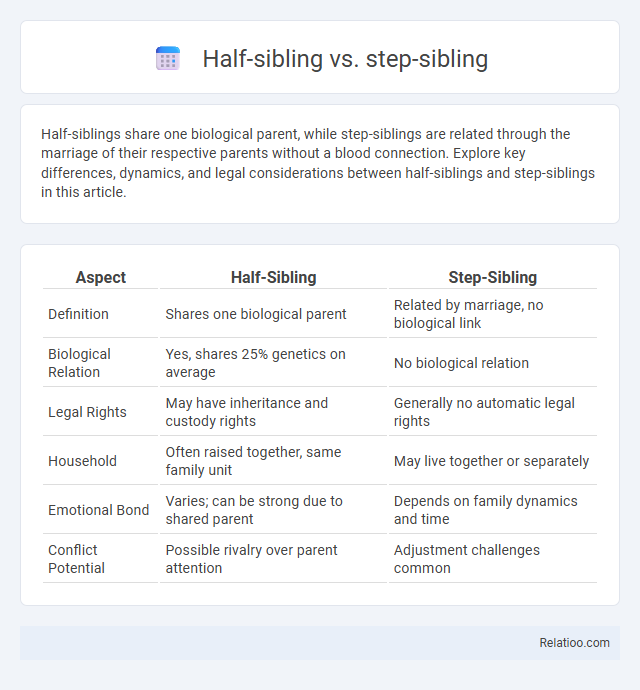Half-siblings share one biological parent, while step-siblings are related through the marriage of their respective parents without a blood connection. Explore key differences, dynamics, and legal considerations between half-siblings and step-siblings in this article.
Table of Comparison
| Aspect | Half-Sibling | Step-Sibling |
|---|---|---|
| Definition | Shares one biological parent | Related by marriage, no biological link |
| Biological Relation | Yes, shares 25% genetics on average | No biological relation |
| Legal Rights | May have inheritance and custody rights | Generally no automatic legal rights |
| Household | Often raised together, same family unit | May live together or separately |
| Emotional Bond | Varies; can be strong due to shared parent | Depends on family dynamics and time |
| Conflict Potential | Possible rivalry over parent attention | Adjustment challenges common |
Understanding Half-Siblings: Definition and Key Traits
Half-siblings share one biological parent, either mother or father, distinguishing them genetically from step-siblings who are related through marriage without biological ties. Understanding half-siblings involves recognizing shared genetic heritage, which can influence familial bonds and identity formation differently than step-sibling relationships. Family cohesion in households with half-siblings often depends on emotional connections and shared experiences, highlighting the complex dynamics beyond mere biological links.
What Are Step-Siblings? Core Characteristics Explained
Step-siblings are children brought together when one parent marries someone who already has children, forming a blended family unit without biological ties. These relationships often depend on family cohesion, which involves emotional bonding, shared experiences, and communication to foster a supportive environment. Unlike half-siblings who share one biological parent, step-siblings build their connection through social and familial interactions rather than genetics.
Biological Connections: Genetics in Half-Siblings
Half-siblings share approximately 25% of their genetic material through one common parent, which establishes a significant biological bond impacting family cohesion. Step-siblings, by contrast, lack a direct genetic connection, as their relationship is formed through marriage rather than biology. Understanding these genetic distinctions helps you appreciate how biological ties influence emotional closeness and family dynamics in blended families.
Legal and Social Bonds: Step-Sibling Relationships
Step-sibling relationships are legally recognized primarily in blended families where no biological connection exists, contrasting with half-siblings who share one biological parent and have inherent legal rights related to inheritance and custody. Social bonds in step-sibling relationships are often shaped by family cohesion efforts, including shared experiences and parental roles rather than genetic ties. Legal frameworks vary by jurisdiction but generally grant fewer automatic rights to step-siblings, emphasizing the importance of social and emotional bonds in fostering family unity.
Family Dynamics: Integrating Half-Siblings and Step-Siblings
Integrating half-siblings and step-siblings within family dynamics requires understanding their distinct genetic and legal relationships, as half-siblings share one biological parent while step-siblings are related through marriage without shared genetics. Family cohesion is influenced by communication patterns, emotional bonds, and shared experiences, which can foster unity despite diverse sibling statuses. Effective integration emphasizes mutual respect, conflict resolution skills, and supportive parenting to nurture a harmonious blended family environment.
Inheritance and Legal Rights: Key Differences
Half-siblings share biological parents, granting them equal inheritance rights under most legal systems, whereas step-siblings generally have no automatic inheritance rights unless legally adopted or explicitly included in wills. Family cohesion can influence the decision to include step-siblings in inheritance plans, emphasizing the importance of clear legal documentation to protect Your assets. Understanding these distinctions ensures that estate planning reflects both familial relationships and legal entitlements accurately.
Emotional Challenges: Navigating Sibling Relationships
Navigating emotional challenges in sibling relationships involves understanding the distinct dynamics between half-siblings and step-siblings, as both variations impact family cohesion differently. Half-siblings share biological ties, which can create complex feelings around identity and loyalty, while step-siblings may face unique challenges in building trust and acceptance due to the lack of shared genetics. You can foster family cohesion by encouraging open communication, empathy, and patience, helping siblings navigate their evolving emotional bonds.
Cultural Perspectives on Half- and Step-Siblings
Cultural perspectives on half-siblings and step-siblings significantly influence family cohesion, often shaping emotional bonds and social roles within blended families. In many cultures, half-siblings are perceived as sharing a deeper genetic connection, which can strengthen loyalty and shared identity, whereas step-siblings may face challenges in forming close bonds due to lack of biological ties. The extent of family cohesion varies widely, with some cultural frameworks emphasizing inclusive kinship and collective upbringing, promoting strong unity among all siblings regardless of biological relation.
Impact on Child Development and Identity
Half-siblings, sharing one biological parent, often experience a stronger sense of genetic connection that positively influences a child's development and identity formation, fostering familiar familial bonds and stability. Step-siblings, without shared genetics but connected through parental marriage, can face more challenges in building cohesion, impacting children's sense of belonging and identity integration depending on the quality of family interactions. Family cohesion involving either half-siblings or step-siblings is crucial for emotional security, improved social skills, and positive self-concept, with consistent supportive relationships mitigating potential identity conflicts and promoting healthy development.
Tips for Blended Families: Fostering Healthy Sibling Bonds
Building strong bonds between half-siblings and step-siblings enhances family cohesion in blended families. You can foster healthy sibling relationships by encouraging open communication, setting clear expectations, and promoting shared activities that create positive experiences. Prioritizing respect for individual differences and celebrating the unique family dynamics helps nurture long-lasting connections.

Infographic: Half-sibling vs Step-sibling
 relatioo.com
relatioo.com